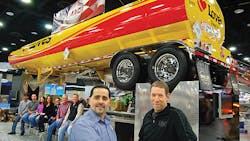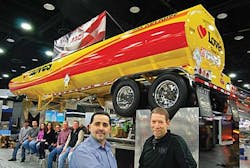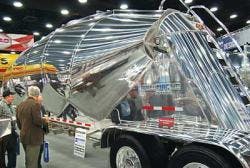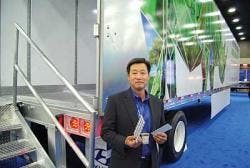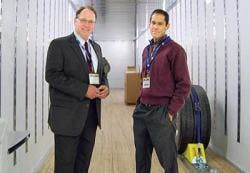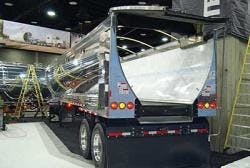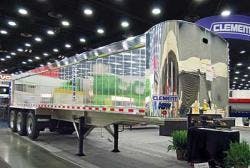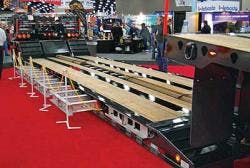Mid-America Trucking Show coverage: Newest trailer designs exhibited at MATS
MAC Liquid Tank Trailers of Kent, Ohio, is a new company under the umbrella of MAC Trailer of Alliance, Ohio. It introduced a brand new petroleum trailer at the Mid-America Trucking Show in Louisville, Ky.
MACLTT is building water tank trailers, crude oil trailers, vacuum trailers, and stainless steel chemical trailers at its 125,000-sq-ft plant in Kent, Ohio. It recently added the Billings, Montana, plant formerly owned by Beall Corp of Portland, Oregon.
The DOT406 barrel is elliptical and has a double-taper design with a drop of 11 inches for better flow It has quarter-inch bulkheads. The three interior compartments are baffled and double-bulkheaded. Compartment sizes are 4,450 gallons, 1,400, and 3,850 gallons. The 9,700-gallon aluminum trailer has a tare weight of 9,200 lb. It is standard bottom-loaded, but has three 16" manholes at top. The ladder is on the front bulkhead.
The tank is mounted on Hendrickson AANT-230 axles with air disc brakes. The aluminum landing stiff legs are made in the MACLTT plant. Aluminum fenders are by Pro-Tec
Pictured with the brightly painted show trailer at right foreground are Ed Mansell, vice-president of MAC Liquid Tank Trailers and Jim Maiorana , president. Seated at left are some of the workers at the Kent and Billings plants who attended the Mid-America Trucking Show. ([email protected])
The top of the four-hopper-cone trailer is curved upward instead of having the usual straight backbone. The top frame consists of aluminum channels welded to the top sheet of each hopper to form a tube. Like other MAC pneumatic dry bulkers, the framing and struts at the front and rear are all enclosed, enhancing it aerodynamic image.
The goal is fuel savings. The food-grade all-aluminum trailer has a volume of 1,625 cubic feet, designed for one bar (14.7 psi) pressure, and weighs 9,600 lb. (www.mactrailer.com)
The 53-ft EcoCell van trailer shown at Mid-America has panels with exterior and interior skins of .016-inch thick galvanized steel and a core of .012-inch thick galvanized steel that is embossed. Weight of the show trailer is 13,100 lb.
Chris Lee, VP-engineering at Hyundai Translead, shows samples of the embossed panel core and the finished panel. He says the 53-ft Eco Cell trailer is about 400 lb lighter than a comparable trailer with composite core panels, and the panels are also stronger. (www.translead.com)
Charles Mudd, president of Vanguard National Trailer Corp (at left), points out that future production might use composite sheet similar to that used on the sidewalls. However, this first prototype was built with an aluminum roof liner. At far right is another innovation, the Modulasi floor tiedown and load blocker. (www.vanguardtrailer.com)
The Trail King continuous belt Super-Hi-Lite agricultural trailer is designed to haul all kinds of feed, seed, and fertilizer on the farm, as well as some more odorous products in urban areas. Therefore, prevention of spillage is important, as is cross contamination.
The Trail King belt has a special flange on both of its outside edges that fits snugly under the sidewall flashing to help prevent product leakage. A spring-loaded belt scraper at the rear cleans off sticky products.
The continuous belt conveyor is 48 inches wide. The curved aluminum sidewalls are covered with high molecular weight (HMW) plastic to prevent load sticking. The top-hinged tailgate sweeps the hopper walls for almost 12 inches to secure a tight seal.
The 43-ft long trailer has a 63-cubic-yard load capacity. Weight is 13,800 lb.(www.trailking.com)
Clement builds many trailers for the market in the Southwest, where frameless dump trailers are very popular. However, this ADW dump trailer at the Mid-America Trucking Show was mounted on a full aluminum frame with three axles. It was designed for the upper Midwest — Minnesota, and Michigan. The third axle allows a five-ft shorter dump trailer to meet the 80,000-lb bridge law, This 34-ft long full-frame dump trailer on three axles with full interior liner and two-speed landing gear scaled 13,240 lb.. The base model without the options has a tare weight of 11,309 lb. (www.clementind.com).
